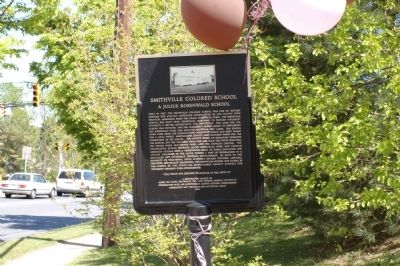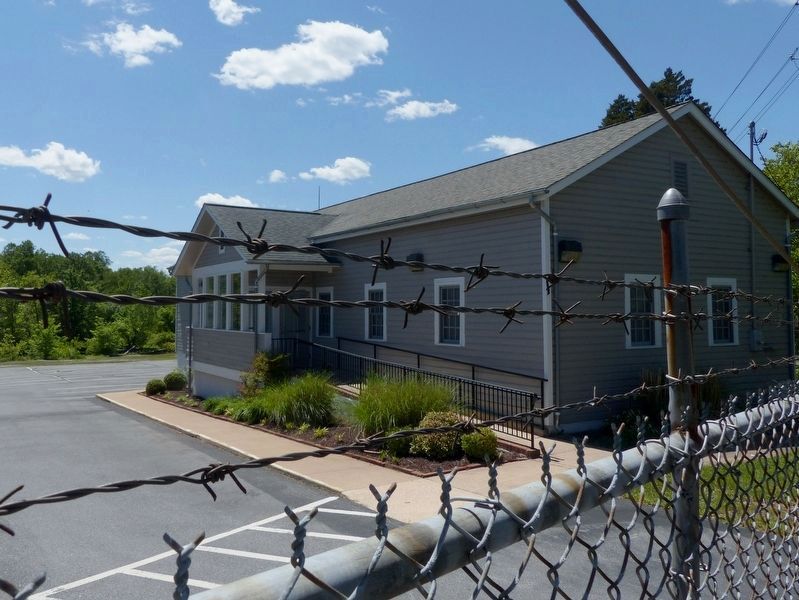Colesville in Silver Spring in Montgomery County, Maryland — The American Northeast (Mid-Atlantic)
Smithville Colored School
A Julius Rosenwald School
Built in 1927, the Smithfield Colored School was one of sixteen schools for African Americans constructed in the county with financial assistance from the Julian Rosenwald Fund. The Smithville school was built near Colesville, Maryland to provide "colored" students a better opportunity for education. The land for the school was donated, and the community raised money to supplement the Rosenwald Fund and donated materials and labor. The school name came from the surrounding community which had been named for a local family. Montgomery County also provided funds for the completion of the school. The county Board of Education operated the school, but the teachers were paid less than the white teachers, the books were previously used, and the supplies limited. The cooperative effort between Julius Rosenwald Fund and African American citizens gave a tremendous boost to public education for African Americans in the South during a time of segregation in a separated but extremely unequal environment. In spite of the disparity of treatment, these students became doctors, lawyers, teachers, and skilled tradesmen. The Smithville School was closed in the spring of 1952 when all Montgomery County schools for "colored" children were consolidated.
“That which was designed to separate us will unite us”
Erected 2005 by Alpha Phi Alpha Fraternity, Iota Upsilon Lambda Chapter, in cooperation with the Montgomery County Historic Preservation Commission and the Maryland Historical Trust.
Topics and series. This historical marker is listed in these topic lists: African Americans • Education. In addition, it is included in the Rosenwald Schools series list. A significant historical year for this entry is 1927.
Location. 39° 4.526′ N, 76° 59.706′ W. Marker is in Silver Spring, Maryland, in Montgomery County. It is in Colesville. Marker is on East Randolph Road just east of New Hampshire Avenue (Maryland Route 650), on the right when traveling east. The marker stands just west of Fairland Road. Touch for map. Marker is at or near this postal address: 811 E Randolph Rd, Silver Spring MD 20904, United States of America. Touch for directions.
Other nearby markers. At least 8 other markers are within 2 miles of this marker, measured as the crow flies. Khmer Rouge Genocide Memorial (approx. 0.6 miles away); Fawcett's Mill (approx. one mile away); Snowden's Mill (approx. 1.1 miles away); Edmonston's Mill (approx. 1.1 miles away); Valley Mill (approx. 1.1 miles away); a different marker also named Valley Mill (approx. 1.1 miles away); The Commonwealth Farm (approx. 1˝ miles away); Kemp Mill (approx. 1.9 miles away). Touch for a list and map of all markers in Silver Spring.
Additional commentary.
1. Who donated the land for the school in 1927
My step-dad was Rufus W. Johnson, son of Charles L. Johnson. Charles donated the 2.0 acres of land for the Smithville Colored School September 22, 1927. He donated the land so that the local children could receive an education.
It is a little disappointing that Charles Johnson's name is not in the remarks on the marker.
In 1999 Rufus Johnson received a letter from Robert Merryman assuring him that the donation would be memorialized.
We are so pleased that the school has become a museum in 2005, but regret that Charles name was left off of the marker. Perhaps this oversight will be corrected. If not for the generous contribution of Charles Johnson, there would not have been a Smithville Colored School. (Mr. Johnson's late wife who passed in 1915, maiden name was Smith). Note To Editor only visible by Contributor and editor
— Submitted October 4, 2013, by Yvonne Robinson of Kerrville, Texas.
2. Smith Village
I grew up in Paint Branch Farms, living there 1956-1970. I remember the "colored school" building, though I never heard its proper name. In my childhood, it was used as a bus barn by the county schools--vivid proof that "separate but equal" schools were far from equal. I started kindergarten in 1957, just after MoCo schools were integrated. I went to Colesville Elementary (since closed) with Smith and Johnson children from what was then called Smith Village, a little east of the school. It was a black community with a long history, or so I was taught. When the area was developed in the early 1960s, the story we heard was that Smith Village families banded together to sell their land collectively, getting more for it than they might have if negotiating one-to-one. The tone of the gossip was that they were smarter than most people, who got shafted by developers. Part of the deal was that each family who wanted one got a new house in the development, right there where they had always lived, in order to keep their community together. You can now see Smith Village Road on Google Maps. It matches my memory of the location (a small road running north off Randolph) and I'm betting that is exactly where the historic Smith Village stood. I remember one of the older houses vividly, b/c it was painted a lovely light blue and could be seen from Randolph Road. That house had personality; I always thought it looked both proud and happy. The community spirit and savvy thinking demonstrated in the story I heard about the sale of Smith Village seems consistent with the forward-looking civic-mindedness of Charles Johnson, who donated land for the Smithville School. Note To Editor only visible by Contributor and editor
— Submitted September 25, 2021, by Susan Tichy of Colorado Springs, Colorado.
Additional keywords. Jim Crow, segregation
Credits. This page was last revised on March 27, 2024. It was originally submitted on May 2, 2006, by Tom Fuchs of Greenbelt, Maryland. This page has been viewed 6,526 times since then and 102 times this year. Last updated on October 25, 2017, by Devry Becker Jones of Washington, District of Columbia. Photos: 1. submitted on May 2, 2006, by Tom Fuchs of Greenbelt, Maryland. 2. submitted on June 29, 2023, by Allen C. Browne of Silver Spring, Maryland. • Bill Pfingsten was the editor who published this page.

